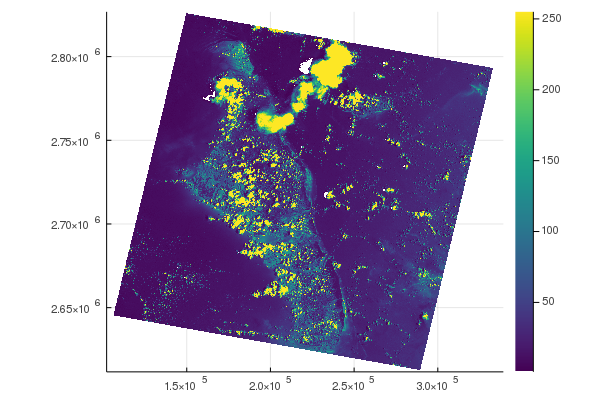Simple geographical raster interaction built on top of ArchGDAL, GDAL and CoordinateTransformations.
A GeoArray is an AbstractArray, an AffineMap for calculating coordinates based on the axes and a CRS definition to interpret these coordinates into in the real world. It's three dimensional and can be seen as a stack (3d) of 2d geospatial rasters (bands), the dimensions are :x, :y, and :bands. The AffineMap and CRS (coordinates) only operate on the :x and :y dimensions.
This packages takes its inspiration from Python's rasterio.
(v1.5) pkg> add GeoArraysjulia> using GeoArrays
# Read TIF file
julia> fn = download("https://github.com/yeesian/ArchGDALDatasets/blob/master/data/utmsmall.tif?raw=true")
julia> geoarray = GeoArrays.read(fn)
100x100x1 Array{UInt8,3} with AffineMap([60.0 0.0; 0.0 -60.0], [440720.0, 3.75132e6]) and CRS PROJCS["NAD27 / UTM zone 11N"...
# Affinemap containing offset and scaling
julia> geoarray.f
AffineMap([60.0 0.0; 0.0 -60.0], [440720.0, 3.75132e6])
# WKT projection string
julia> geoarray.crs
GeoFormatTypes.WellKnownText{GeoFormatTypes.CRS,String}(GeoFormatTypes.CRS(), "PROJCS[\"NAD27 / UTM zone 11N\",GEOGCS[\"NAD27\",DATUM[\"North_American_Datum_1927\",SPHEROID[\"Clarke 1866\",6378206.4,294.978698213898,AUTHORITY[\"EPSG\",\"7008\"]],AUTHORITY[\"EPSG\",\"6267\"]],PRIMEM[\"Greenwich\",0],UNIT[\"degree\",0.0174532925199433,AUTHORITY[\"EPSG\",\"9122\"]],AUTHORITY[\"EPSG\",\"4267\"]],PROJECTION[\"Transverse_Mercator\"],PARAMETER[\"latitude_of_origin\",0],PARAMETER[\"central_meridian\",-117],PARAMETER[\"scale_factor\",0.9996],PARAMETER[\"false_easting\",500000],PARAMETER[\"false_northing\",0],UNIT[\"metre\",1,AUTHORITY[\"EPSG\",\"9001\"]],AXIS[\"Easting\",EAST],AXIS[\"Northing\",NORTH],AUTHORITY[\"EPSG\",\"26711\"]]")
# Create, reference and write a TIFF
julia> ga = GeoArray(rand(100,200))
julia> bbox!(ga, (min_x=2., min_y=51., max_x=5., max_y=54.)) # roughly the Netherlands
julia> epsg!(ga, 4326) # in WGS84
julia> GeoArrays.write!("test.tif", ga)# Find coordinates by index
julia> coords(geoarray, [1,1])
2-element StaticArrays.SArray{Tuple{2},Float64,1,2}:
440720.0
3.75132e6
# Find index by coordinates
julia> indices(geoarray, [440720.0, 3.75132e6])
2-element StaticArrays.SArray{Tuple{2},Int64,1,2}:
1
1
# Find all coordinates
julia> coords(geoarray)
101×101 Array{StaticArrays.SArray{Tuple{2},Float64,1,2},2}:
[440720.0, 3.75132e6] [440720.0, 3.75126e6] [440720.0, 3.7512e6] ...
...# Translate complete raster by x + 100
julia> trans = Translation(100, 0)
julia> compose!(ga, trans)
# Math with GeoArrays (- + * /)
julia> GeoArray(rand(5,5,1)) - GeoArray(rand(5,5,1))
5x5x1 Array{Float64,3} with AffineMap([1.0 0.0; 0.0 1.0], [0.0, 0.0]) and undefined CRSjulia> using InverseDistanceWeighting # or any solver from the GeoStats ecosystem
julia> ga = GeoArray(Array{Union{Missing, Float64}}(rand(5, 1)))
julia> ga.A[2,1] = missing
[:, :, 1] =
0.6760718768442127
missing
0.852882193026649
0.7137410453351622
0.5949409082233854
julia> GeoArrays.interpolate!(ga, InvDistWeight(:z => (neighbors=3,)))
[:, :, 1] =
0.6760718768442127
0.7543298370153771
0.852882193026649
0.7137410453351622
0.5949409082233854# Plot a GeoArray
julia> using Plots
julia> fn = download("https://github.com/yeesian/ArchGDALDatasets/blob/master/pyrasterio/RGB.byte.tif?raw=true")
julia> ga = GeoArrays.read(fn)
julia> plot(ga)
# or plot a band other than the first one
julia> plot(ga, band=2)
